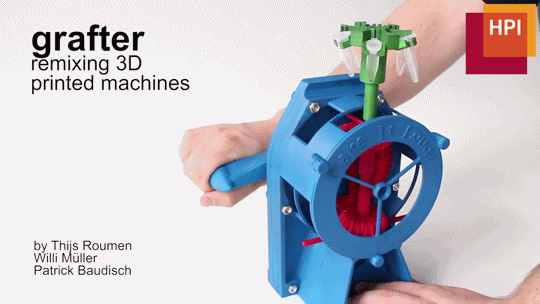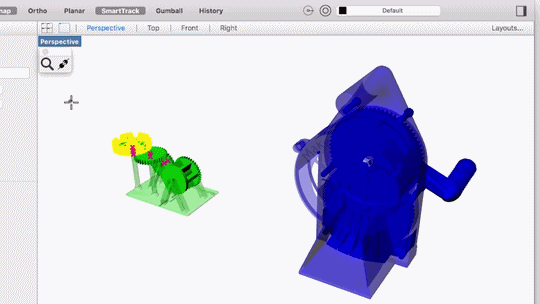The Hasso Plattner Institut (HPI), a design, digital and engineering institute at the University of Potsdam has developed the Grafter 3D software system, which allows users to remix 3D models machines and create working mechanisms that can be 3D printed.
As part of a proof of concept study, researchers from HPI’s Human-Computer Interaction Lab (HCIL) took three parent designs from the online 3D object platform and remixed them into a working contraption.
The Grafter project aims to shift attention away from object-based remixing towards mechanism based remixing.
The problem with mechanical remixing
Remix culture plays an important part in 3D printing communities and maker movements. Often, when incorporating elements of many machines, practitioners often have to take apart the original designs and manually fit mechanical components together.
In many cases, individual components will have to be extensively redesigned so that they are compatible with the other components that in the final mechanism.
Past research has seen the development of an algorithm that enables hobbyists to 3D print wind-up toys at home, but retaining previously created mechanical parts when remixing mechanisms is not has not been broached by many studies.

Remixing without reinventing the wheel
Researchers from the HPI, which has previously developed locks using 3D printed metamaterials decided to develop a new software to get around this problem.
The Grafter software both identifies groups of mechanical elements that function together and automates the process of extracting and recombining mechanical elements within machines.
It allows users to re-use the knowledge and engineering experience that went into modeling original mechanisms saving them the effort of tweaking, testing, and prototyping the mechanism until it works.
Grafter first annotates the mechanisms in all the parent models, a process that takes between 10 minutes to an hour per model. The remixing takes a matter of minutes and final models can then be 3D printed.

Recycling a machine from scratch
As a proof of concept, three “parent” models were selected from the online object platform Thingiverse: a siren with a crank and wheel shaft, a record player and a “waterfuge” (a centrifuge with a revolving test tube rack).
Guided by the user, Grafter extracts the relevant mechanisms and allows the user to drag and drop them into other models to make a new machine. When the user searches for a particular component, the software semi-automatically identifies the suitable part.
For the study Grafter selected a record player’s gears, axles, and axle geometry as useful, and imported them, while discarding the crank and the turntable. This was also done with the siren’s gearbox and waterfuge’s test tube rack, producing a functional mechanism that can be 3D printed.
The researchers who conducted the study, Thijs Roumen, Willi Mueller and Patrick Baudisch will now present their findings in April at the CHI 2018 conference in Montreal.
Let us know which 3D printing application has been most important to you this year. Make your nominations for the 3D Printing Industry Awards 2018 now.
For more stories on 3D printing and remix culture, subscribe to our free 3D Printing Industry newsletter, follow us on Twitter, and like us on Facebook.
Featured image shows Possible models that can be designed and 3D printed from parent objects. Photo via HPI.

